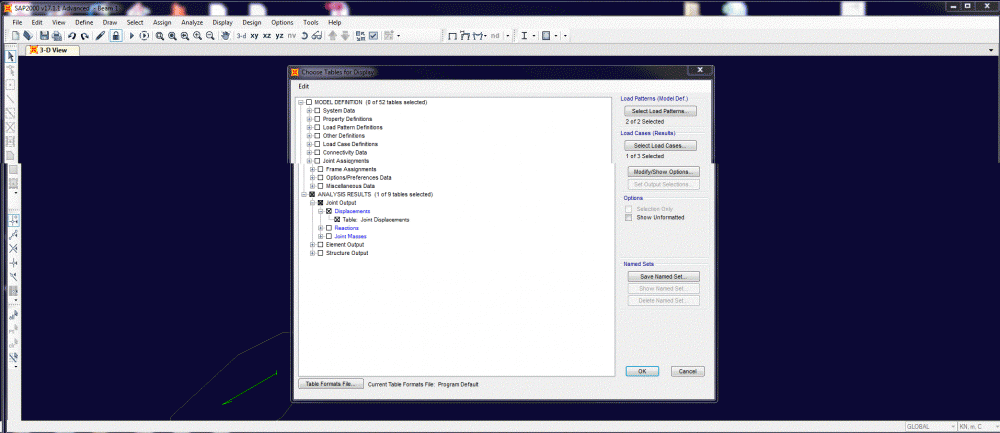-
Posts
1470 -
Joined
-
Last visited
-
Days Won
446
Content Type
Profiles
Forums
Events
Everything posted by UmarMakhzumi
-

serviceability requirements in Etabs
UmarMakhzumi replied to Prince Saleem's topic in Software Issues
One way of doing it is to assign joints at all beams centre. After analysis is complete you can go to Analysis output and report joint displacement for load case you are interested. It will give you a table that you can either copy to excel or export as an excel file. See attached for SAP2000. Thanks. -

How to solve bending moment probelm ETABS
UmarMakhzumi replied to Alinalysis's topic in Software Issues
You are welcome. Before deciding whether to ignore torsion or include torsion in the design, you need to understand if it is compatibility torsion or equilibrium torsion. For your case above, you can justify ignoring torsion by not providing any negative reinforcement at the end of Beam 1 that is supported on Beam 2. To understand the differences between the two kinds of Torsion, please read the following article. Thanks a lot. -

How to solve bending moment probelm ETABS
UmarMakhzumi replied to Alinalysis's topic in Software Issues
For torsion modification factors and its use, please see the link below. You will have to detail your beam Beam 1 without any negative moment so that it produces no torsion in Beam 2. Like I said, I don't have access to ETABS so I can't check why your moments are the way they are. Thanks. -
What is the error? Over-stressed in combined shear and torsion? Thanks.
-
Is this under the dead weight load combination or a lateral load combination? Thanks.
-

How to solve bending moment probelm ETABS
UmarMakhzumi replied to Alinalysis's topic in Software Issues
I am not sure about your questions. Anyway, If you split the beam, make sure beam 2 is continuous. Like I said before, your beam 1 end would be pinned. Also, you can use snap tools to connect beam 1 at beam 2 location without splitting it. If your beam column connection is pinned, then you will have no bending moment. If you design to provide a moment connection, you will have to change that in your model. You decide what you want and you tweak your model accordingly. Thanks. -

Beams and Columns Over-stressed Next to Shearwall
UmarMakhzumi replied to asadishaq's topic in Software Issues
The only detailing that comes to my mind to achieve the aforesaid is to provide a steel section between length of concrete column that allows hinge behavior. However, that might be a construction nightmare as you will need to use embedment plates. So from a practical standpoint- if your system is a dual system, your frame (columns+beams) should be only resisting 30% (or 35% I don't remember exactly) of the total base shear. So you can have two separate models (like you will have for any dual system analysis) and check that condition. If they pass then you should be fine as that is the minimum required strength that your columns need to meet. Thanks. -
If that is the case then term warranty might refer to something else than design life. More from a contracts point of view, perhaps!
-

How to solve bending moment probelm ETABS
UmarMakhzumi replied to Alinalysis's topic in Software Issues
Please see the image below for hanger bars. I don't have ETABS. I do have SAP2000 so I can't check your file. Is your beam failing? Thanks. -
Nouman, Warranty should be equal to or more than the design life of structure, which is 50 years as per most building codes. Just a FYI. Thanks.
-

Beams and Columns Over-stressed Next to Shearwall
UmarMakhzumi replied to asadishaq's topic in Software Issues
Asadishaq, Are these steel columns or concrete. Do you plan to provide a special connection that reflects a hinge in actual construction too? Thanks. -

How to solve bending moment probelm ETABS
UmarMakhzumi replied to Alinalysis's topic in Software Issues
Hi Alinalysis, There might a reason for why you are getting such moment distribution. Please share your model and someone with ETABS might be able to help it out. Regarding 2, Yes you can do that. I normally provide hanger bars when one beam is supported over another and I release the moment for the end that is supported (that would be end of beam 1 supported on beam 2). Thanks. -
For concrete you need PCA Notes on ACI Code. They cover most of the examples for concrete. Thanks.
-
To add to what Uzair has said, Zamil Steel and Mammut do a lot of pre-engineered big sheds (with cranes running above etc) in Pakistan. You should contact them.
-

Default Skin
UmarMakhzumi replied to UmarMakhzumi's topic in Website Announcements/ Problems/ Login/ Registration Issues
Thanks for the feedback. I think the autosave will work much better under the new upgrade. We can have the modification added but I will have to engage someone or get a hook. So lets check the upgrade and if it doesn't then I will try my best to incorporate it. Thanks. -

Default Skin
UmarMakhzumi replied to UmarMakhzumi's topic in Website Announcements/ Problems/ Login/ Registration Issues
Uzair, I am working on it. I have contacted Invision Power Board and asked them to upgrade the forum. Here is a list of all the major updates: https://community.invisionpower.com/blogs/entry/9737-ips-community-suite-41-preview-available/ Updates to Editor: https://community.invisionpower.com/blogs/entry/9739-ips-community-suite-41-editor-update/ Activity Streams: https://community.invisionpower.com/blogs/entry/9738-ips-community-suite-41-activity-streams-and-menu-manager/ Hopefully we will have the upgrade soon. Thanks. -

Single Story Parking Structure_ A Case Study
UmarMakhzumi replied to Sami Ullah Khan Bangash's topic in Software Issues
You should do it if that provide the worst case results. Sorry, can't check your model because I don't have ETABS. Thanks. -

Default Skin
UmarMakhzumi replied to UmarMakhzumi's topic in Website Announcements/ Problems/ Login/ Registration Issues
Probably we shouldn't be updating the skin then? -
Welcome aboard Nouman! Thanks.
-

Etabs 2015 Analyzing Problem, Please Help!!!
UmarMakhzumi replied to kemal's topic in General Discussion
Licensed should be fine. Generally cracked versions are buggy. Anyhow, I am not familiar with this situation. Did you try contacting the CSI help desk? Thanks. -

Etabs 2015 Analyzing Problem, Please Help!!!
UmarMakhzumi replied to kemal's topic in General Discussion
Kemal, Do you have authentic license for ETABS/ Safe or are you using a cracked version? Thanks. -

How To See The Reactions Under Shear Wall ?
UmarMakhzumi replied to mhdhamood's topic in Concrete Design
Good stuff Shaker. Walls are like beams. Assume NA and do the math. I though your question was more related to reactions not adding up but anyway, looking at the answer I get it that it was more about verifying moment against vertical reactions. Thanks. -
Hi Shahzad, I don't have literature reference but here is what I do based on common sense engineering. First I calculate the overall settlement of raft with piles. Generally for that, recommendations are provided in the geotechnical report on how to calculate it. Once I know the total settlement, I use that information to calculate pile spring value (load/settlement) and use that in my analysis. I have also seen some engineers doing the same thing but using extremely soft spring values to design raft and using real numbers to calculate pile capacity. Its just a conservative approach. Thanks.



